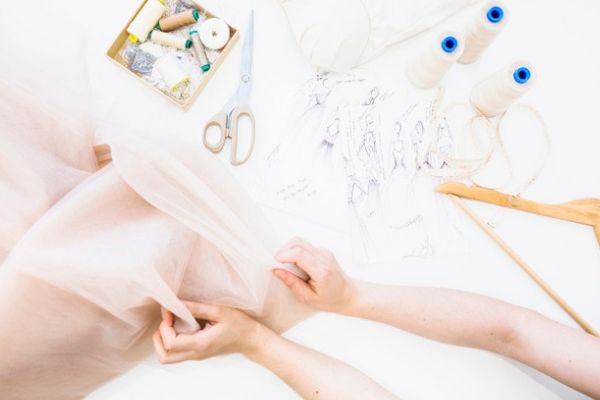India’s ancient and once highly respected textiles and garment industries are experiencing a renaissance. The nationwide buzz generated by the Lakme India Fashion Week staged in Mumbai annually, is an indicator that Indias ancient and once highly respected textiles and garment industries are experiencing a renaissance.
Unlike in an earlier era when textile designing in India was a hereditary profession handed down from generation to generation, in todays competitive age when the textile and garment industries have to keep pace with ephemeral trends and preferences of the crystallising global market, there is a growing demand for professionally qualified textile designers.
Some textile design professionals have already established themselves as haute couture fashion designers and their creations range from exclusive sarees to prêt-a-porter garments which are marketed in chic boutiques and mushrooming retail chain stores. Among them: Tarun Tahiliani, Rohit Bal, Ritu Beri, J.J. Vallaya, Abraham & Thakore, Malini Ramani, Manoviraj Khosla etc. These new generation fashion gurus have set their sights on national and global markets for their highly creative textiles and off-the-peg garments. Not surprisingly they are constantly looking for textile and garment designers endowed with creativity, resilience, self-confidence, and talent. Most textile design institutes of learning in the country require Plus Two as the minimum qualification. Thereafter aptitude tests which evaluate artistic ability, spatial perception, and aesthetic and colour sensitivity are administered to applicants. The selection process also evaluates attitude, motivation, and interest together with academic qualifications, general awareness, scientific, and technical aptitude.
The duration of the study programmes in textile design ranges from two to five years. Polytechnics run by state governments as also private sector edupreneurs offer two to three-year courses in one or more specialised areas of industrial design including textile design (commonly offered by womens polytechnics). Some art colleges offer specialisation in textile design as a component of their bachelor of fine arts (BFA) degree courses.
Among them:
Sir J.J. School of Arts, Mumbai
College of Arts and Craft, Lucknow
Kala Bhawan, Shantiniketan
Lalit Kala Institute, Jabalpur
College of Art, New Delhi
Banaras Hindu University, Varanasi
Allahabad University, Allahabad
Apeejay Institute of Design, New Delhi
Pearl Academy of Fashion, Delhi, Jaipur and Chennai
NATIONAL INSTITUTE OF DESIGN. The most comprehensive study programme in industrial design (which includes textile design) is offered by the National Institute of Design (NID), Ahmedabad. Christened the School Leavers Professional Education Programme (SLPEP), it is of five years duration during which students go through a mandatory foundation course followed by optional specialisations, one of which is textile design.
NID has devised a three-prong admission programme. Initially it scrutinises applica-tion forms to evaluate factors such as motivation, interest, attitude, and perception for a career in design as revealed by applicants answers to questions set out in the form. After careful scrutiny, shortlisted applicants are sum-moned for an admission test which evaluates competence in mathematics, science, social studies (secondary school standard), and drawing/sketching. Applications for SLPEP are advertised in October, the written test is conducted in January and interviews follow in April/May.
A two-year diploma course in textile design and development (TDD) is also offered by the National Institute of Fashion Technology (NIFT), New Delhi. This programme is open to graduates with a 50 percent average.
With the domestic fashion industry booming, there is constant demand for artistic and innovative textile designers. A rash of freelancers have set up shop in the metros in particular and most of them are inundated with assignments. Moreover, a growing number of textile manufacturing companies have their own design ateliers and beginners could start off with monthly pay packet of Rs.10,000 plus. Also, in the fray are fashion consultancy firms which have sprung up and earn good profits.
With the IT boom of the past decade, creativity in textile design has attained a new high. The choice of colours and patterns designers can create and mix and match are mind-boggling. Moreover work has become much easier and faster with computers,” says Kavita Koppikar, a successful Mumbai-based textile designer who freelances for several top fashion houses and teaches at the G.D. Somani Polytechnic, Mumbai, which offers a one-year diploma programme in textile design.
Working for up-market fashion houses, Koppikar needs to put in overtime at her workshop in Kandivli which offers spray-painting, hand painting, tie and dye, screen printing on fabrics, and design enhancement services. A quarter century in textile design following a three-year course from Sophia Polytechnic, Mumbai, and 10 years on-the-job experience with the Thackersey Group of mills as a designer while simultaneously teaching textile design at her alma mater has helped Koppikar hone her skills.
She entertains no doubt that the demand for textile and garment specialists is on the upswing and its likely to accentuate as quota barriers crumble in the new WTO regime. The restructured Indian textile industry has a good future, particularly smaller mills and boutiques designing and finishing customised and exclusive fabrics. With fashion being driven by textiles and fabrics and a discerning haut monde, trendsetting designers can hitch their wagon to the stars,” says Koppikar.
